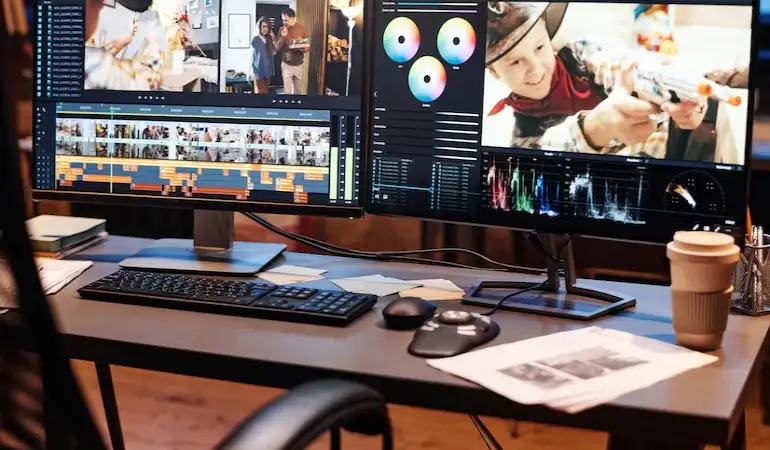How to Optimize your PC for Video Editing
Video editing is much more than editing the background or blurring unnecessary components in the camera footage.
October 06, 2024 10:56
Video editing can push your PC to its limits. Whether you're working on simple projects or dealing with heavy 4K footage, optimizing your system is essential to ensure smooth workflows, faster render times, and fewer crashes. If you're frustrated by laggy playback or sluggish rendering, this guide will help you optimize your PC for video editing.
Understanding the System Requirements for Video Editing
Before diving into optimizations, it's crucial to understand the baseline requirements for video editing. Depending on your editing software and the complexity of your projects, system requirements can vary.
For casual video editors working on 1080p footage, a mid-range CPU, 8-16GB of RAM, and a decent GPU will suffice. But if you're working with 4K or 8K footage, professional color grading, or heavy visual effects, you'll need a high-end CPU, a powerful GPU, and at least 32GB of RAM.
Minimum and Recommended System Requirements:
- CPU: Quad-core processor or higher
- RAM: 16GB for HD, 32GB+ for 4K editing
- GPU: Dedicated graphics card (4GB VRAM minimum)
- Storage: SSD for operating system and project files
Importance of CPU in Video Editing Performance
The CPU (Central Processing Unit) is one of the most critical components in video editing. It handles the majority of the computational tasks, from rendering effects to encoding footage.
Multi-core Processors vs. Single-core Processors
Modern video editing software is optimized to take advantage of multi-core processors. Having more cores allows your computer to process multiple tasks simultaneously, making it ideal for rendering and encoding video. For example, an Intel i7 or Ryzen 7 processor with 8 or more cores will significantly speed up your workflow compared to a dual-core processor.
Optimizing Your PC’s CPU for Video Editing
To get the most out of your CPU, there are several optimizations you can implement.
Enabling CPU Boost and Hyper-Threading
Ensure that features like CPU boost or turbo boost are enabled. These features automatically increase the CPU clock speed when your system needs extra power. Also, enable hyper-threading (on compatible CPUs), which allows each core to handle two threads at once, improving multitasking performance.
Overclocking for Video Editing Performance
Overclocking can push your CPU beyond its stock speed. While this can improve performance, it's not without risks. Overclocking generates more heat and can reduce the lifespan of your CPU if not done carefully. If you're considering overclocking, make sure you have adequate cooling and monitor your system temperatures closely.
The Role of RAM in Video Editing
RAM (Random Access Memory) is essential for managing large files and multitasking during video editing. The more RAM you have, the easier it is for your PC to handle high-resolution footage without slowing down.
How Much RAM Do You Need?
For HD video editing, 16GB of RAM should be sufficient. However, for 4K or 8K editing, you’ll want at least 32GB. RAM speed also plays a role—higher clock speeds can lead to smoother performance, especially when dealing with large project files.
Maximizing RAM Usage
To ensure your RAM is being used efficiently, close unnecessary background applications that may consume memory. This frees up resources for your editing software.
Upgrading RAM
If you find your PC struggling with large files or heavy effects, consider upgrading your RAM. Most modern PCs allow for RAM upgrades, and the difference in performance can be significant.
Why GPU is Crucial for Video Editing
The GPU (Graphics Processing Unit) handles graphic rendering, especially during tasks like real-time playback and applying effects. While the CPU does the heavy lifting, the GPU ensures your video previews run smoothly without lag.
GPU Acceleration and Video Editing
Many editing software programs, like Adobe Premiere Pro and DaVinci Resolve, offer GPU acceleration. This offloads certain tasks from the CPU to the GPU, speeding up processes like rendering and playback.
Choosing the Right GPU
If you're serious about video editing, invest in a dedicated GPU with at least 4GB of VRAM. NVIDIA’s RTX series or AMD’s Radeon cards are great options for video editors. Ensure that your software supports GPU acceleration for your chosen card.
The Importance of Fast Storage Solutions
When working with large video files, storage speed can have a huge impact on your workflow. Traditional hard drives (HDDs) are much slower than solid-state drives (SSDs). An SSD allows for faster read and write speeds, reducing the time it takes to open, save, and render files.
SSD vs. HDD
For optimal performance, use an SSD for your operating system and video editing software. Store your media files and projects on a secondary SSD or fast external drive. This way, your system won't be bogged down by slow data retrieval from an HDD.
Storage Management Tips
To avoid clutter and improve performance:
- Keep your operating system and software on one drive, and your project files on another.
- Use external drives or NAS systems for long-term storage and backups.
- For faster access, consider a RAID setup, which combines multiple drives for improved speed and redundancy.
Display and Monitor Considerations for Video Editing
When editing video, your monitor plays a significant role in ensuring accurate color representation and smooth playback.
Why Color Accuracy and Resolution Matter
For professional editing, a high-resolution monitor with accurate color representation is essential. A 4K monitor allows you to see your footage in its full resolution, while accurate color ensures your final product looks great on all devices.
Optimizing Monitor Settings for Editing
Calibrating Your Monitor
Color calibration tools can ensure your monitor displays colors accurately. This is crucial for editors working on color correction or grading projects.
Refresh Rates and Response Times
For smoother playback, opt for a monitor with a high refresh rate (60Hz or higher). Lower response times also help reduce motion blur, making video previews crisper and clearer.
Keeping Your PC Cool During Video Editing
Video editing can generate a lot of heat, especially during rendering. Keeping your system cool is essential for maintaining performance and preventing thermal throttling, where your PC slows down to avoid overheating.
Cooling Solutions
There are two main types of cooling: air cooling (fans) and liquid cooling. Fans are more affordable but can be noisy, while liquid cooling offers more efficient cooling but is more expensive.
Tips to Improve PC Cooling
- Regularly clean your PC to remove dust from fans and vents.
- Ensure proper airflow by organizing cables and keeping your PC in a well-ventilated area.
Software Tweaks and Optimization for Video Editing
Keeping Your Editing Software Updated
Always keep your video editing software and drivers up to date. Updates often include performance improvements and bug fixes.
Optimizing Software Settings
Adjusting your software settings can lead to better performance. For example, reducing playback quality in Premiere Pro can help prevent lag during editing.
Conclusion
Optimizing your PC for video editing doesn't have to be daunting. By ensuring your hardware is up to the task and making a few tweaks, you can significantly improve your editing experience. Whether you're a casual editor or a professional working on complex projects, these optimizations will help you work faster and more efficiently.











